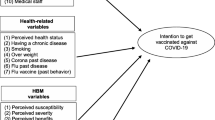Summary
A person's perception of the risk of, or susceptibility to, developing a disease is believed to be an important determinant of health-related behavior, yet little is known about the determinants of perceived risk. Knowledge of these correlates may be useful in identifying and addressing barriers to performance of health behaviors such as mammography screening. Data collected from over 36,000 women participating in a breast cancer screening program in Texas were used to examine the associations between perceived risk of ever getting breast cancer and a number of demographic factors, health-related behaviors, and risk factors for breast cancer. There was a strong positive association between family history of breast cancer and risk perception (OR=11.3, CI=10.34−12.35). Women who reported other risk factors for breast cancer also reported higher perceived risk, but those associations were of lesser magnitude. Age was inversely associated with perceived risk, and black, but not Hispanic, women were more likely to perceive their risk as high compared with white women. Of the health-related behaviors for the early detection of breast cancer, only having had a prior mammogram was associated with perceived risk. Educational interventions to heighten women's awareness of breast cancer risk factors may increase perceived risk in high risk women and influence their decision to undergo screening mammography.
Similar content being viewed by others
References
Slovic P, Fischhoff B, Lichtenstein S: Why study risk perception? Risk Anal 2:83–93, 1982.
Rosenstock IM: The Health Belief Model and preventive health behavior. Health Educ Monogr 2:354–386, 1974.
Janz NK, Becker MH: The Health Belief Model: a decade later. Health Educ Q 11:1–47, 1985.
Burack RC, Liang J: The early detection of cancer in the primary-care setting: factors associated with the acceptance and completion of recommended procedures. Prev Med 16:739–751, 1987.
Burack RC, Liang J: The acceptance and completion of mammography by older black women. Am J Public Health 79:721–726, 1989.
Calnan M: The Health Belief Model and participation in programmes for the early detection of breast cancer: a comparative analysis. Soc Sci Med 19:823–830, 1984.
Rutledge DN, Hartmann WH, Kinman PO, Winfield AC: Exploration of factors affecting mammography behaviors. Prev Med 17:412–422, 1988.
Lerman C, Rimer B, Trock B, Balshem A, Engstrom PF: Factors associated with repeat adherence to breast cancer screening. Prev Med 19:279–290, 1990.
Polednak AP, Lane DS, Burg MA: Risk perception, family history and use of breast cancer screening tests. Cancer Detect Prev 15:257–263, 1991.
Zapka JG, Stoddard AM, Costanza ME, Greene HL: Breast cancer screening by mammography: utilization and associated factors. Am J Public Health 79:1499–1502, 1989.
Vogel VG, Peters GN, Evans WP, et al: Design and conduct of a low-cost mammography screening project: experience of the American Cancer Society, Texas Division. Am J Roentgenol 158:51–54, 1992.
SPSS-X User's Guide, 3rd edition: SPSS Inc., Chicago, Illinois, 1988.
BMDP Statistical Software: 1983 printing with additions. University of California Press, Berkeley, California, 1983.
Bondy ML, Vogel VG, Halabi S, Lustbader ED: Identification of women at increased risk for breast cancer in a population-based screening program. Cancer Epidemiology, Biomarkers and Prevention 1:143–147, 1992.
Taplin S, Anderman C, Grothaus L: Breast cancer risk and participation in mammographic screening. Am J Public Health 79:1494–1498, 1989.
National Research Council: Improving Risk Communication. National Academy Press, Washington, D.C., 1989.
Nelkin D: Communicating technological risk: the social construction of risk perception. Annu Rev Public Health 10:95–113, 1989.
Slovic P: Informing and educating the public about risk. Risk Anal 6:403–415, 1986.
Covello V, von Winterfeldt D, Slovic P: Risk communication: a review of the literature. Risk Abstracts 3:171–182, 1986.
Fessenden-Raden J, Fitchen J, Heath J: Providing risk information in communities: factors influencing what is heard and accepted. Science Technology and Human Values 12:94–101, 1987.
Kasperson RE, Renn O, Slovic P, Brown HS, Emel J, Goble R, Kasperson JX, Ratick S: The social amplification of risk: a conceptual framework. Risk Anal 8:177–187, 1988.
Rappaport RA: Toward postmodern risk analysis. Risk Anal 8:189–191, 1988.
Rip A: Should social amplification of risk be counteracted? Risk Anal 8:193–197, 1988.
Stern PC: Learning through conflict: a realistic strategy for risk communication. Policy Sciences 24:99–119, 1991.
Fitchen JM, Heath JS, Fessenden-Raden J: Risk perception in community context: a case study.In: Johnson BB, Covello VT (eds) The Social and Cultural Construction of Risk. D. Reidel Publishing Co., Boston, Massachusetts, 1987, pp 31–54.
Ajzen I, Fishbein M: Understanding Attitudes and Predicting Social Behaviors. Prentice Hall, Englewood Cliffs, New Jersey, 1980.
Harding CM, Eiser JR: Characterising the perceived risk and benefits of some health issues. Risk Anal 4:131–141, 1984.
Costanza ME, D'Orsi CJ, Greene HL, Gaw VP, Karellas A, Zapka JG: Feasibility of universal screening mammography: lessons from a community intervention. Arch Intern Med 151:1851–1856, 1991.
Cockburn J, Murphy B, Schofield P, Hill D, Borland R: Development of a strategy to encourage attendance for screening mammography. Health Educ Res 6:279–290, 1991.
Reynolds HE, Jackson VP: Self-referred mammography patients: analysis of patients' characteristics. Am J Roentgenol 157:481–488, 1991.
Vogel VG, Graves DS, Vernon SW, Lord JA, Winn RJ, Peters GN: Mammographic screening of women with increased risk of breast cancer. Cancer 66:1613–1620, 1990.
Kaplan KM, Weinberg GB, Small A, Herndon JL: Breast cancer screening among relatives of women with breast cancer. Am J Public Health 81:1174–1179, 1991.
Vernon SW, Vogel VG, Halabi S, Jackson GL, Lundy RO, Peters GN: Breast cancer screening behaviors and attitudes in three racial/ethnic groups. Cancer 69:165–174, 1992.
Rimer BK, Keintz KM, Kessler HB, Engstrom PF, Rosan JR: Why women resist screening mammography: patient-related barriers. Radiology 172:243–246, 1989.
Rimer BK, Trock B, Engstrom PF, Lerman C, King E: Why do some women get regular mammograms? Am J Prev Med 7:69–74, 1991.
Author information
Authors and Affiliations
Rights and permissions
About this article
Cite this article
Vernon, S.W., Vogel, V.G., Halabi, S. et al. Factors associated with perceived risk of breast cancer among women attending a screening program. Breast Cancer Res Tr 28, 137–144 (1993). https://doi.org/10.1007/BF00666426
Issue Date:
DOI: https://doi.org/10.1007/BF00666426




